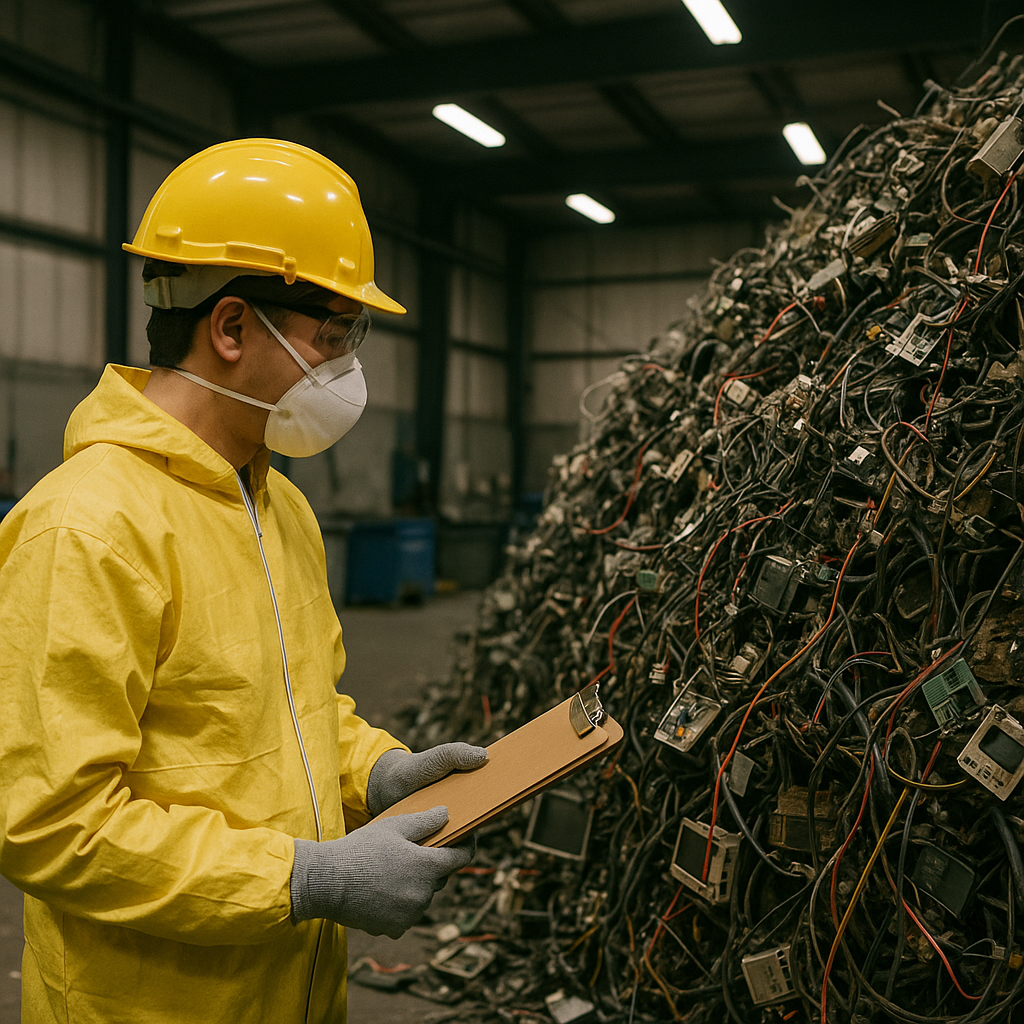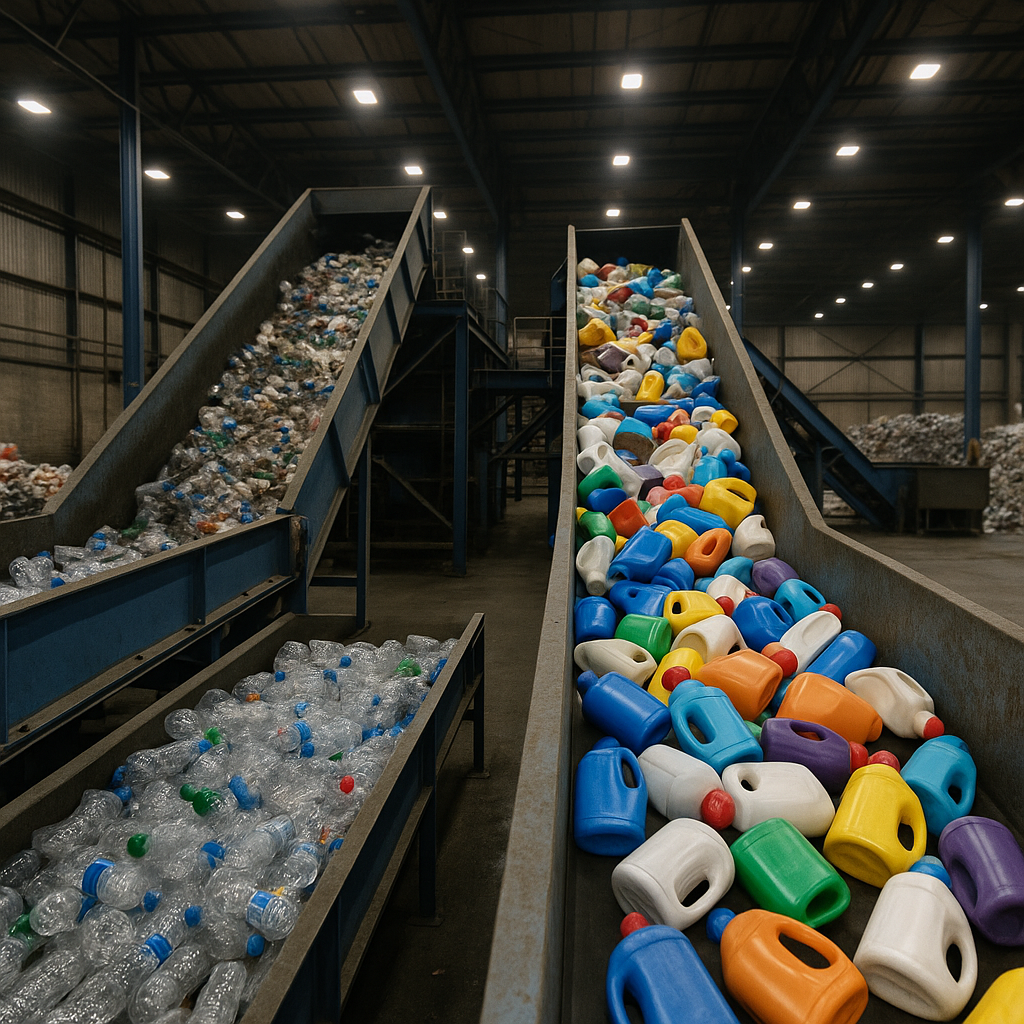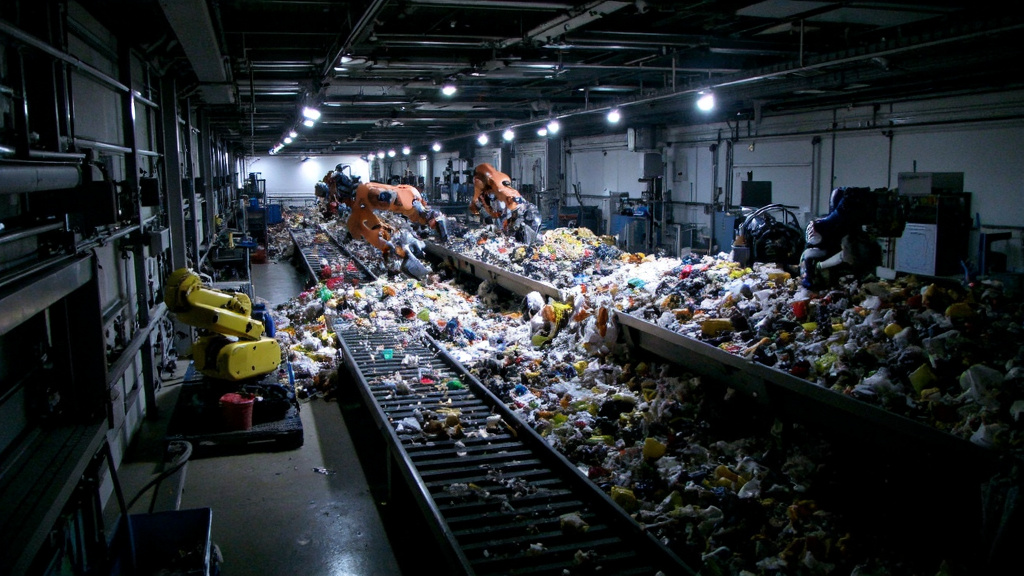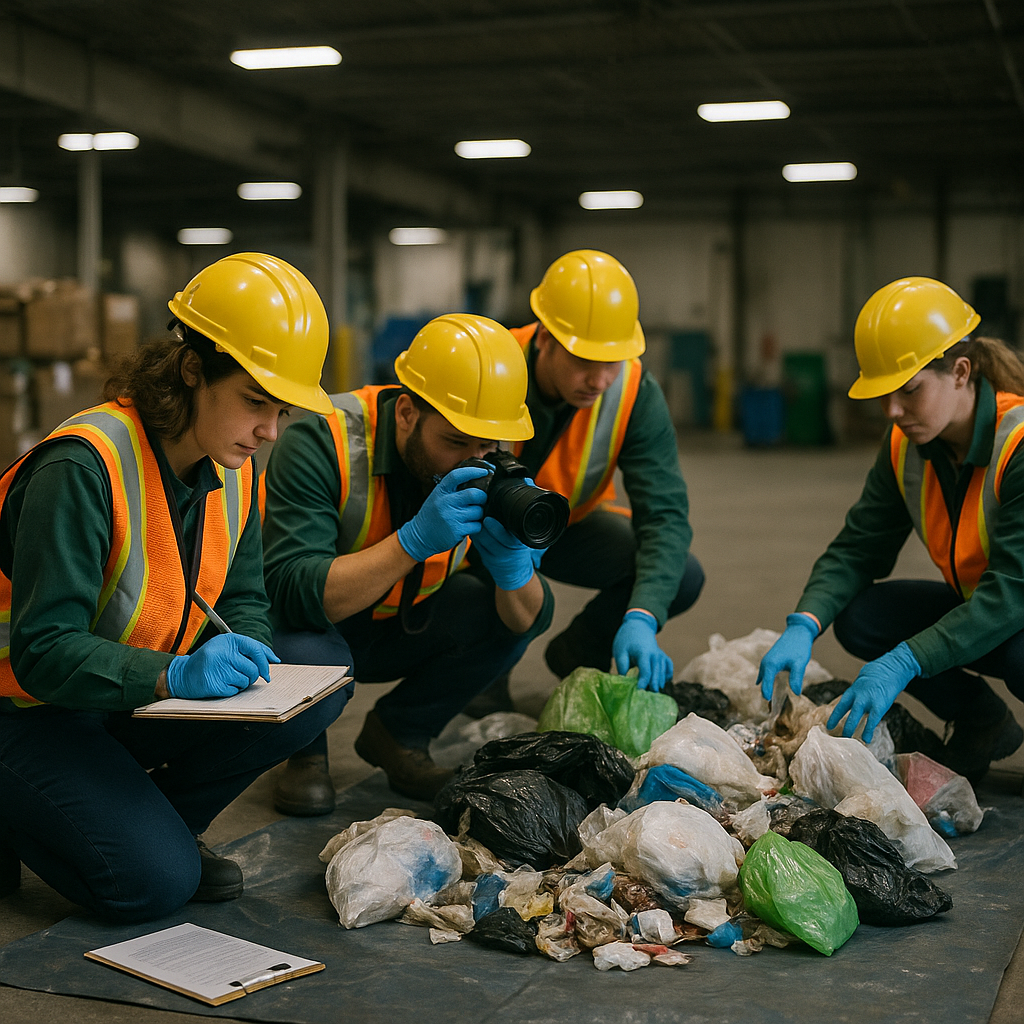5901 Botham Jean Blvd, Dallas, TX 75215
What Is a Commercial Waste Audit?
July 2, 2025A commercial waste audit is a systematic assessment that examines what businesses discard. It provides a clear picture of waste generation patterns and disposal practices within an organization. The process involves collecting, sorting, and analyzing all waste streams produced by a company over a specific period.
Most commercial waste audits cover about one week. During this time, all trash and recyclables are carefully collected and categorized. Waste audit specialists sort materials by type, weigh each category, and document the findings with detailed records.
The primary goal is to understand exactly what fills your dumpsters. A properly conducted waste audit reveals not only the types and quantities of waste generated but also the specific sources within your operation. This information is invaluable for businesses aiming to reduce their environmental footprint, comply with regulations, and cut disposal costs.
What Are the Key Benefits of Conducting a Waste Audit?

Cost Savings Through Waste Reduction
Waste audits reveal immediate financial opportunities that many businesses overlook. By examining your waste stream, you can identify recyclable materials currently sent to landfills at premium disposal rates. Findings from over 100 global waste audits indicate that up to 62% of materials in typical commercial trash could be recycled or composted.
These misplaced resources translate directly into unnecessary expenses. A properly conducted waste audit uncovers potential savings in hauling fees, which continue to rise annually. For instance, one business campus found that food scraps made up a large percentage of their trash. By implementing an organics program, their waste load was reduced by 25%, significantly lowering disposal costs.
Audits also highlight purchasing inefficiencies. In one office, nearly 30% of their waste volume was disposable coffee cups. They switched to reusable mugs, eliminating a recurring expense and demonstrating environmental leadership.
Enhanced Program Effectiveness
A waste audit provides concrete data on your current waste management system, revealing critical breakdowns in the recycling process, such as contamination issues that can compromise entire loads of possibly recyclable materials.
This visibility allows for targeted improvements instead of guesswork. During an audit, you might find that recyclables end up in trash bins due to inadequate signage or inconvenient bin placement. These insights enable strategic adjustments to collection points, container design, and educational messaging.
Audits also reveal opportunities to implement new recycling streams for previously overlooked materials. A manufacturing facility might find valuable metal scraps or packaging materials with specialized recycling markets, potentially creating new revenue streams while diverting waste.
Compliance Assurance and Reporting Benefits
Waste audits provide documentation to help businesses meet regulatory requirements. Many jurisdictions now mandate specific waste diversion rates or reporting practices, particularly for certain industries or larger facilities.
The data collected during audits serves as evidence of compliance efforts and creates a baseline for improvement. This information is also valuable for sustainability reporting, whether for internal benchmarking, stakeholder communications, or formal frameworks like CSR or GRI reporting.
For facilities pursuing certifications like LEED, waste audits are often mandatory. They provide the verification needed to demonstrate adherence to waste management standards and can contribute valuable points toward certification goals.
Employee Engagement and Cultural Impact
The waste audit process creates valuable opportunities for staff education and involvement. Engaging employees in the audit or sharing the results can build awareness about waste generation patterns and their environmental impact.
When staff members see the actual composition of workplace waste, it often triggers behavioral changes. A financial institution conducted recycling training after an audit revealed 22% of their trash consisted of recyclables. A follow-up audit showed this figure had dropped to 15%, meeting sustainability targets and boosting employee morale.
Waste audits can serve as launching points for broader sustainability initiatives. The visual impact of sorted waste makes the abstract concept of an environmental footprint tangible, helping catalyze support for new policies or programs.
Data-Driven Decision Making
One key benefit of waste audits is that they replace assumptions with facts. Without audit data, waste management decisions rely on guesswork.
This data enables accurate tracking of progress over time. By establishing baseline measurements and conducting regular follow-up audits, businesses can quantify improvements, set realistic goals, and demonstrate ROI for waste reduction initiatives.
Audits also verify the accuracy of waste hauler data, crucial for operational oversight and billing verification. This information is invaluable when renegotiating service contracts or conducting waste removal RFPs.
| Waste Type | Common Percentage of Total Waste | Notes |
| Paper | 25% | Mostly office paper |
| Plastics | 17% | Single-use containers |
| Compostables | 31% | Food waste dominant |
| Cardboard | 30% | Often recyclable |
| Metals | Includes recyclables like scrap metal |
How Do You Conduct a Commercial Waste Audit?

A commercial waste audit offers crucial insights into your waste generation patterns and highlights opportunities for cost savings and environmental improvements. The process is methodical and requires careful planning to ensure accurate results. Here are the essential steps to conduct an effective commercial waste audit.
Form a Cross-Functional Audit Team
Assemble a diverse team with representatives from different departments. This cross-functional approach provides various perspectives on waste habits across your facility. Include facility managers aware of the building layout, department representatives familiar with daily operations, and maintenance staff knowledgeable about existing waste systems.
Assign clear responsibilities to each team member. Someone should manage logistics, another may handle data collection, while others sort through materials. Training team members on safety protocols, sorting categories, and data recording methods enhances efficiency and accuracy throughout the audit process.
Set Clear Objectives
Define what you aim to learn from your waste audit before starting. Specific goals will guide your methodology and ensure meaningful results. Common objectives include identifying main waste components by volume or weight, calculating recycling contamination rates, finding potential cost savings, and establishing baseline measurements for future comparison.
Prioritize these objectives based on your organization’s needs. Are you trying to reduce landfill waste, cut disposal costs, or meet sustainability targets? Your goals should be specific, measurable, achievable, relevant, and time-bound to drive tangible outcomes.
Choose an Appropriate Audit Window
Select a typical week that accurately represents normal business operations for your audit. Avoid periods with unusual activities, special events, or major staff absences that might skew results. A standard audit window is five to seven days, providing enough data to establish reliable patterns.
If operations vary seasonally, consider multiple audits throughout the year to capture different operational phases. Notify all staff about the upcoming audit and ensure custodial teams do not remove waste during the collection period.
Gather Necessary Equipment
Assemble all required tools before starting the audit. Essential protective equipment includes heavy-duty gloves, safety glasses, aprons or coveralls, and hand sanitizer. For measurement and sorting, you’ll need digital scales, sorting tables or tarps, containers for different waste categories, and data collection forms.
Prepare a clean, well-ventilated space with enough room for your team to work comfortably. Having all supplies ready demonstrates professionalism and makes the audit process smoother. Safety should always be the top priority during waste handling.
Collect and Categorize Waste
During the audit window, gather waste from designated areas throughout your facility. Label each bag with the date and department where it was collected. On the audit day, empty contents onto a sorting surface and categorize materials into clearly labeled bins.
Common waste categories include paper, cardboard, plastics (by type if possible), glass, metals, food waste, and non-recyclable items. Weigh each category separately and record the data. Taking photographs of the sorted piles provides visual documentation and can be useful for training purposes.
Analyze Your Findings
Once sorting is complete, analyze the data to identify patterns and opportunities. Calculate your waste diversion rate by dividing the weight of recyclable materials by the total waste weight and multiplying by 100. This percentage shows how much waste is currently being diverted from landfills.
Look for recyclable materials discarded as trash, excessive amounts of certain waste types, and contamination in recycling streams. This analysis will highlight areas where improvements can significantly impact your waste management practices.
Develop and Communicate Action Plans
Based on your analysis, develop specific recommendations for enhancing waste management practices. Prioritize actions based on potential impact and ease of implementation. Common recommendations include introducing additional recycling stations, improving signage, providing staff training, or partnering with specialized recycling services.
Share the audit results and action plans with all stakeholders in clear, engaging formats. For leadership, focus on financial benefits and compliance improvements. For employees, emphasize the environmental impact and how their actions contribute to company goals.
Schedule regular follow-up audits to measure progress and maintain momentum. Quarterly mini-audits can help track improvements, while a comprehensive annual audit provides deeper insights into long-term trends.
Common Challenges and Solutions
Even well-planned waste audits face challenges. Limited time and resources can hinder audit efforts. Consider starting with a mini-audit focused on one area before expanding. This approach requires fewer resources while still providing valuable data.
Employee participation can be challenging. To overcome resistance, clearly communicate the purpose and benefits before the audit begins. Provide proper training on waste sorting procedures and recognize departments that show improvement.
Data accuracy is crucial for meaningful results. Develop clear, standardized categorization systems and use consistent weighing procedures. Train staff on proper material identification and take photographs for verification purposes.
What Insights Can Be Gained from a Waste Audit?

Identifying Waste Composition and Major Streams
A waste audit offers a detailed analysis of your waste composition, revealing which materials dominate your waste stream and in what quantities. Many businesses uncover surprising insights about their disposal patterns during this process.
The audit categorizes waste into specific streams such as paper, plastics, organics, and metals. Understanding these proportions helps focus reduction efforts where they’ll have the greatest impact. For instance, a university waste audit found that 75% of generated waste could be diverted from landfill through effective recycling and composting programs.
This detailed waste composition data enables businesses to make evidence-based decisions rather than relying on assumptions for their waste management strategies.
Uncovering Cost-Saving Opportunities
Waste audits often highlight areas where companies are overpaying for waste services, such as unnecessary pickups or using inappropriately sized containers for their actual waste volume.
These financial insights can be substantial, identifying materials with potential rebate value that are currently being landfilled. For example, clean cardboard, certain plastics, and metals might generate revenue through recycling programs instead of incurring disposal costs.
Audit data allows businesses to renegotiate service contracts based on actual needs rather than estimates, leading to immediate cost reductions.
Revealing Recycling and Diversion Opportunities
Waste audits are invaluable for identifying recyclable materials currently ending up in general waste. Many organizations are surprised to find significant amounts of recyclables going to landfill.
Audits highlight materials with high recycling potential that warrant dedicated collection systems, and they identify contamination issues in current recycling programs that might reduce effectiveness or increase costs.
This knowledge allows businesses to implement targeted recycling initiatives that significantly boost diversion rates. When materials are properly sorted and recycled, the environmental benefits increase while disposal costs decrease.
Establishing Baseline Metrics for Improvement
Waste audits provide crucial baseline data for measuring future improvements. Without this benchmark, companies lack the metrics needed to set realistic waste reduction goals or assess progress.
The audit data enables the calculation of key performance indicators such as waste diversion rates, per-employee waste generation, and waste management costs per unit. These metrics are powerful tools for tracking progress over time.
Organizations can use these baselines to set specific, measurable targets for waste reduction. For example, identifying that 30% of their waste stream consists of recyclable paper may prompt a goal to reduce that figure by half within six months through improved collection systems.
Informing Employee Education and Engagement
Waste audit findings provide concrete evidence to drive behavioral change, as the visual impact of sorted and quantified waste often motivates improvement among staff.
Results highlight specific behaviors that need addressing through targeted education, such as composting if food waste is a major component of landfill-bound waste.
The insights gained can guide the development of effective signage, bin placement, and training programs tailored to actual workplace waste challenges, rather than generic recycling messages. This targeted approach typically achieves higher compliance rates.
Supporting Sustainability Reporting and Compliance
Quantitative data from waste audits supports regulatory compliance and sustainability reporting requirements, with many jurisdictions requiring businesses to report waste generation and diversion statistics.
Audit findings provide the documentation needed for environmental certifications and sustainability frameworks. This data helps demonstrate an organization’s environmental commitment to stakeholders, customers, and partners.
For companies with sustainability goals, waste audit data offers concrete metrics to report progress to leadership and external stakeholders, enhancing transparency and credibility.
| Insight | Action |
| Significant portion of waste stream identified as recyclables or compostables | Implement dedicated recycling and composting programs |
| Presence of contamination issues within recycling bins | Enhance employee training and improve signage |
| High volume of a particular recyclable material (e.g., coffee cups) | Switch to reusable alternatives |
| Findings from over 100 global waste audits show up to 62% recyclability | Optimize waste sorting and diversion processes |
| Waste loads containing significant food scraps | Introduce organics collection and composting |
| Recyclables ending up in trash bins due to inconvenient placement | Reorganize and strategically place bins |
A comprehensive waste audit transforms guesswork into strategic action. By revealing precisely what is in your waste stream, where it originates, and how it is managed, audits lay the foundation for meaningful waste reduction. These insights empower businesses to implement targeted improvements that benefit both the environment and the bottom line.
Conclusion: Maximizing the Value of Your Commercial Waste Audit

A commercial waste audit gives businesses a solid framework to convert waste management from a routine cost to a strategic benefit. By systematically examining waste streams, companies uncover opportunities to reduce disposal costs, improve operational efficiency, and enhance their environmental reputation.
The financial benefits of regular waste audits are significant and often realized quickly. Most businesses find they can reduce waste expenses by 30-40% within the first quarter after implementing audit recommendations. Beyond immediate savings, waste audits help companies identify valuable recyclable materials that might otherwise end up in landfills, creating potential revenue streams while reducing disposal fees.
Environmental benefits extend well beyond cost savings. Companies that adopt waste audit recommendations typically reduce their landfill contributions by 2-3 tons monthly, significantly lowering their carbon footprint. This improved environmental performance strengthens community relationships and appeals to eco-conscious customers, employees, and investors.
If your business is ready to optimize waste management practices, reduce costs, and improve environmental performance, contact Okon Recycling at 214-717-4083. Our team of experts can help you design and implement a waste audit program tailored to your specific needs and guide you through the process of transforming your waste management approach.
